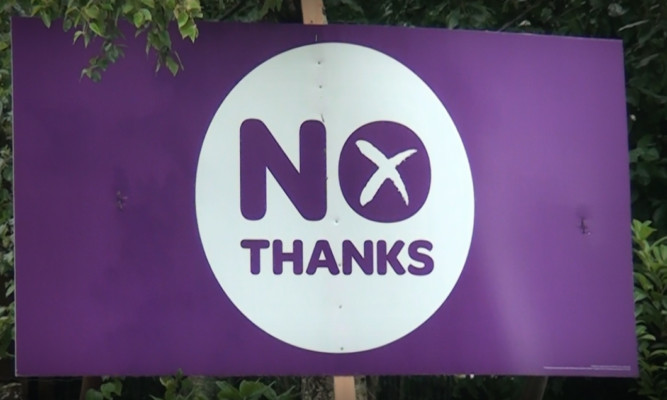Fife has voted overwhelmingly to stay as part of the UK in the Scottish independence referendum.
Following significant delays caused by computer glitches during the count result at the Michael Woods Sport and Leisure Centre in Glenrothes, it was announced at 6.10am that 139,788 Fife voters had voted No (55%) with 114,148 voting Yes (45%).
There were 226 rejected papers comprising 53 marked Yes and No, 12 discarded because of written marks and 161 declared unmarked or void.
Turnout in Fife was confirmed as 84.1% with 254,162 out of a potential 302,108 registered voters.
Better Together campaigner, Dunfermline and West Fife Labour MP Thomas Docherty, told The Courier: “From Kincardine to the Tay Bridge, the No campaign has been out there on the streets, talking to voters calmly and addressing their questions and on issues like Rosyth Dockyard for example in west Fife understood that there was a clear choice between the positive case for 50 years of work and vague aspirations from the SNP White Paper.
He added: “I think the YouGov poll (which gave Yesa a narrow lead a fortnight ago) was a huge wake up call not just for the campaign but to the people of Fife as a whole. Where we saw some big wins tonight in Fife, the parties put aside their differences to work together.”
Conceding defeat, SNP Fife councillor and Yes Scotland referendum agent for Fife John Beare said he was “disappointed yes, down and out no”. He said: “We fought a wonderful campaign considering we started at 30%. We’ve increased by about 12%. We’ve won the argument but not by enough.”
SNP MSP for Mid Scotland and Fife Annabelle Ewing said she would “accept the democratic decision of the people”.
She said that in spite of the result, there had been “good results” in particular Fife communities where there had been “real strong engagement”.
She added:”We’ll look at the result in terms of what comes next. We’ll also look at the vow made by the three unionist parties in the last week.”
Within minutes of 385 polling stations closing in Fife last night, counting got under way.
As the main counting hall filled with 180 enumerators at 36 counting tables, Fife Council chief executive and counting officer Steve Grimmond introduced the main officials responsible for overseeing the Fife count.
There were rumours on social media that some Fife voters had been refused a vote after being told they’d already submitted a postal vote.
But in a statement released by Fife Council last night, Mike Melville, Team Manager/Adviser (Committee Services), with Fife Council said: “In the weeks and months leading up to the Referendum, Fife Council rolled out information and advice on the voting process through media and social media. This included urging people who had not received their postal vote or polling card (eg they may have moved house) by September 3 to contact the Electoral Registration Team immediately otherwise they might lose their vote.”
Revealing that proceedings at Fife’s polling stations had run smoothly throughout the day, Mr Grimmond told count staff: “It’s really important that if any concerns are raised (during the count) they should be brought to our attention immediately. Accuracy is more important than speed.”
As the first boxes were tipped onto the tables, observers from both the Yes and No camps – including several Fife councillors and MSPs – scrutinised each table under the watchful eye of the media on the balcony above. Wifi problems and computer glitches led to a delay of several hours to the declaration.
As the third largest local authority in Scotland with a population of 366,910, the number of people registered to vote in Fife for the independence referendum was confirmed as 302,108.
This included 8155 people aged between 16 and 18.
The council also confirmed that 55,704 postal votes had been issued with 2221 people requesting a proxy vote.
Experts had predicted that Fife’s result could go a long way towards predicting the national picture with the region seen as a microcosm of Scotland with its diverse economy and socio-economics.
